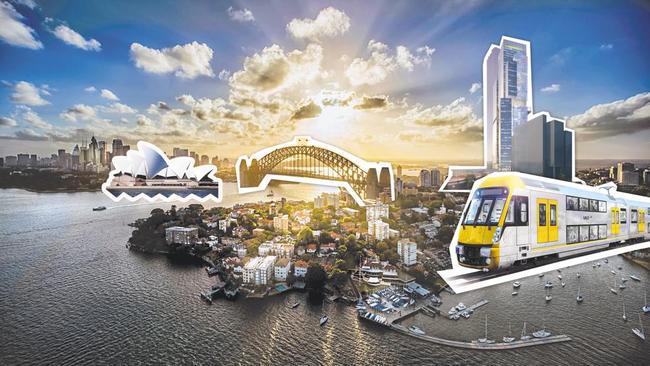Budget 2016: Now NSW is now really travelling
IT’S take off for Badgerys Creek. The government is pledging $115 million to remove a massive powerline and forge an environmental-impact statement.
NSW
Don't miss out on the headlines from NSW. Followed categories will be added to My News.
IT is take off for Badgerys Creek airport, with the government pledging $115 million to remove a massive powerline and forge an environmental-impact statement and rail design concept in anticipation for the project’s completion by the mid 2020s.
The Budget papers state the funding will also be used for minor land acquisitions, planning and development for the major Western Sydney project.
The government said the $115 million to fund preparation work would include $26 million to develop a concept design for rail access that would accelerate benefits to Western Sydney, while $89 million would also be allocated to undertake critical preparatory activities for the airport site.
“The Western Sydney Airport Environmental Impact Statement and Airport Plan are both expected to be finalised in the coming months following the review of nearly 5000 public submissions and it is anticipated that the proposed Western Sydney Airport will commence operations in the mid-2020s,” it said.
“The airport would be expected to handle around 10 million passengers around five years after it opens for business. By that time the airport would provide nearly 9000 direct jobs, and this would grow to more than 60,000 direct jobs by the early 2060s.”
According to government officials, the “preparatory work” involves removing a 300 kilovolt power line that goes across the site and working with Transgrid to relocate it, possibly underground.
The federal government still hopes a private operator will build and operate the airport and Sydney Airport has first right of refusal under its contract.
“The concept design for the provision of rail services to the site will be prepared with assistance from Transport for NSW and will recommend any preparatory works to ensure the WSA site is rail ready.”
In all $2.9 billion was promised for NSW infrastructure in the Budget.

The Sydney Metro will get $1.7 billion, Parramatta Light Rail $78.3 million, with regional roads the New England Highway, Princes Highway and Newell Highway to get tens of millions each in an election Budget infrastructure package.
Much of the funding was revealed this week by The Daily Telegraph and $2.19 billion of it comes from money promised through the “asset recycling fund” matching with a 15 per cent contribution from the Baird government’s leasing of the electricity poles and wires.
By tying that funding to projects like the Metro and the Parramatta light rail, Prime Minister Malcolm Turnbull is differing from his predecessor Tony Abbott, who preferred to use federal money to fund roads rather than public transport.
It will also allow the government to have some say in the Metro project and possibly direct the Rouse Hill to Bankstown line out to Badgerys Creek Airport.
“The government has finalised or committed to agreements with four states and territories under the Government’s Asset Recycling Initiative, worth $3.3 billion.
This will catalyse $23 billion in additional infrastructure investment in projects including the Sydney and Melbourne metro projects, light rail in Parramatta, regional road and rail freight corridors across NSW and Victoria,” Treasurer Scott Morrison said in his budget speech yesterday.
The government committed $52.2 million in pinch points and clearways, $30.3 million for the New England Highway, $52.5 million for the Princes Highway, $5.7 million and $78.8 million for the Newell Highway.
It had committed in previous budgets to $412 million for the NorthConnex (F3 to M2) motorway project, $1.5 billion for the WestConnex motorway and hundreds of millions more for Western Sydney roads.
“The government will also establish a $2 billion Water Infrastructure Loan Facility which will catalyse new investment in dams and pipelines across Australia,” Mr Morrison also promised in his Budget speech.
Deputy Prime Minister Barnaby Joyce said the scheme “to support major water infrastructure projects over 10 years” would begin in July and “help get priority projects up and running through providing concessional loans to the states and territories”.
$600 MILLION KICK START FOR RURAL RAIL LINK
Jim O’Rourke
A PROPOSED $10 billion inland rail line linking Melbourne with Brisbane, via western NSW, is a step closer after the government said it will provide nearly $600 million in “additional equity” from next financial year.
The farm lobby has been urging the government to help fund the project designed to make rural producers more competitive by massively improving interstate freight movements.
National Farmers Federation chief executive Tony Mahar has called on Treasurer Scott Morrison to make a firm commitment to help fund the project.
The Budget Papers said the government will provide additional equity of $594 million, over three years from 2017-18, to the Australian Rail Track Corporation for land acquisition to create the rail corridor, which will also be a link to major ports.
Close to $3.8 million has been set aside to test whether the private sector would be interested in financing and delivering the line. The spending is subject to an equity funding agreement between the government and the ARTC.
In a report released last year by former federal Nationals leader John Anderson, the cost of building and upgrading the rail network across NSW, Victoria and Queensland was put at least $10 billion.
Mr Anderson has been calling for the government to put at least $1 billion towards the line in this Budget. He said if a major funding commitment was not made, the whole project should be scrapped.
Mr Morrison said the money will be allocated to Inland Rail as part of the $50 billion National Infrastructure Plan. “We know that an inland rail link will help to integrate domestic markets and bring global markets close to home,” he said.
“This is particularly important to leverage the benefits of our export trade agreements for Australian agriculture.”


